A Gendered Organizational Analysis of the ... - Campus Activism
A Gendered Organizational Analysis of the ... - Campus Activism
A Gendered Organizational Analysis of the ... - Campus Activism
Create successful ePaper yourself
Turn your PDF publications into a flip-book with our unique Google optimized e-Paper software.
gay rights stance (and a Queer Caucus), its role in <strong>the</strong> struggle against heterosexism, both as a tool <strong>of</strong> sexism and<br />
an evil <strong>of</strong> its own accord, is a critical organizational element. Focusing on gender narrows <strong>the</strong> scope <strong>of</strong> this<br />
investigation, but also blunts its applicability by <strong>the</strong>orizing a false equality <strong>of</strong> all women. Unfortunately this may<br />
be an unavoidable necessity, since, for instance, analyzing race in SEAC would be a major endeavor. Acker’s<br />
focus on <strong>the</strong> ‘job’ and methods <strong>of</strong> job evaluation is not that useful for my analysis <strong>of</strong> SEAC, which has many<br />
undefined or poorly defined positions.<br />
Mats and Billing (1997) complicate Acker’s <strong>the</strong>ory with <strong>the</strong>ir example <strong>of</strong> a Swedish advertising agency<br />
which in some aspects follows untraditional feminine values and whose workers claim to work in a liberated<br />
environment, but it also shows signs <strong>of</strong> being gendered male (sex segregation, objectification <strong>of</strong> women). Like<br />
<strong>the</strong> advertising agency, SEAC shows a tension between being gendered male in some aspects and female in<br />
o<strong>the</strong>rs.<br />
Background on SEAC<br />
SEAC was formed in 1988 by a group <strong>of</strong> students from UNC Chapel-Hill who put an advertisement in<br />
Greenpeace magazine about starting a national student environmental organization and received two hundred<br />
replies. Students organized a series <strong>of</strong> very successful conferences (national and regional), <strong>the</strong> largest <strong>of</strong> which<br />
drew 7600 students to University <strong>of</strong> Illinois at Urbana-Champaign in 1991. Since <strong>the</strong>n SEAC has become <strong>the</strong><br />
largest grassroots progressive student organization in <strong>the</strong> United States, with approximately a thousand groups,<br />
had as many as a dozen concurrent staff members, published a national magazine, organized campaigns, held<br />
trainings, and held many conferences. In 1995 SEAC experienced an internal crisis, lost all <strong>of</strong> its funding, its<br />
entire staff, and closed <strong>the</strong> national <strong>of</strong>fice. Since <strong>the</strong>n SEAC has partially recovered – though <strong>the</strong> national <strong>of</strong>fice<br />
is a shell <strong>of</strong> what it once was.<br />
Methodology<br />
I first became involved with SEAC in <strong>the</strong> fall <strong>of</strong> 1996 when I got an email about a regional<br />
environmental conference in PA from some organization that I had never heard <strong>of</strong> (SEAC) and drove ten hours<br />
from Indiana to attend. The conference was very impressive. I attended <strong>the</strong> following spring conference and<br />
6



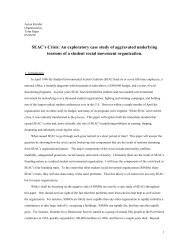
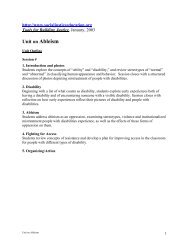

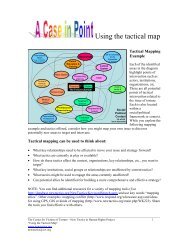
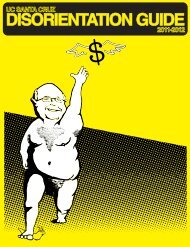

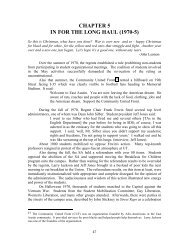
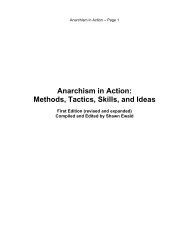



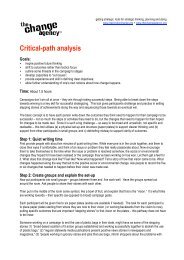

![Meaningful Student Involvement Research Guide [pdf] - SoundOut](https://img.yumpu.com/38822556/1/190x231/meaningful-student-involvement-research-guide-pdf-soundout.jpg?quality=85)